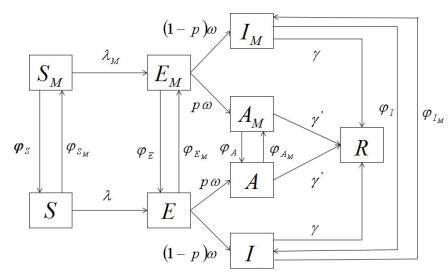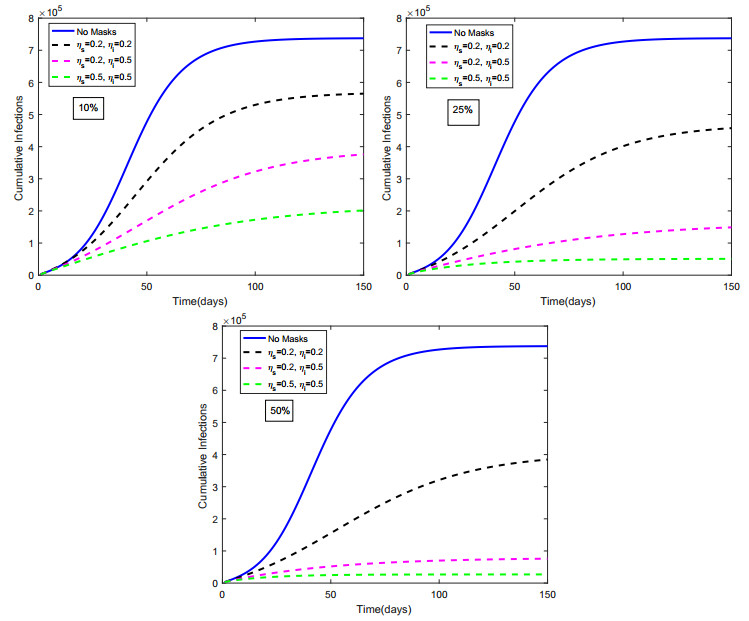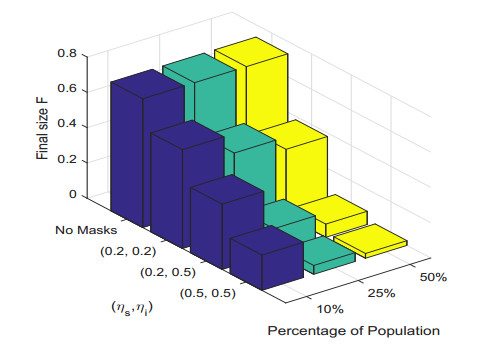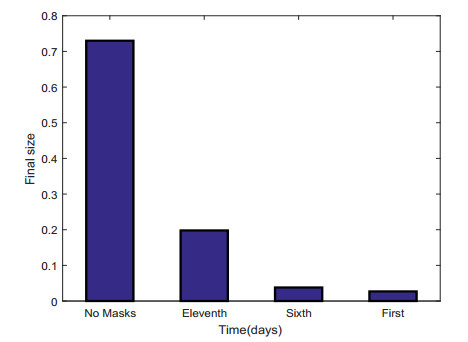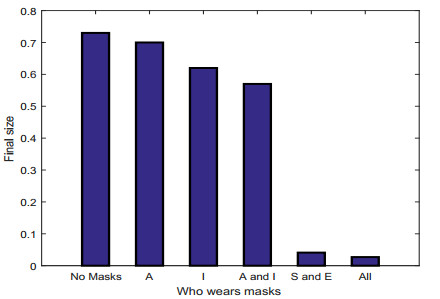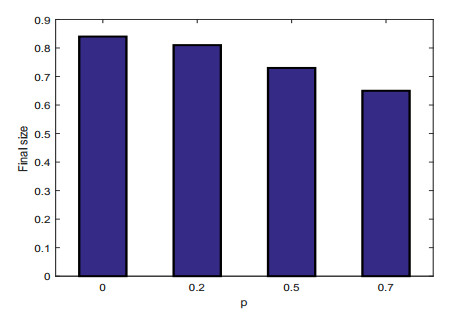We consider an SIR epidemic model with
discontinuous treatment strategies. Under some reasonable
assumptions on the discontinuous treatment function, we are able to
determine the basic reproduction number $\mathcal{R}_0$, confirm the
well-posedness of the model, describe the structure of possible
equilibria as well as establish the stability/instability of the
equilibria. Most interestingly, we find that in the case that an
equilibrium is asymptotically stable, the convergence to the
equilibrium can actually be achieved in finite time, and we
can estimate this time in terms of the model parameters, initial
sub-populations and the initial treatment strength. This suggests
that from the view point of eliminating the disease from the host
population, discontinuous treatment strategies would be superior to
continuous ones. The methods we use to obtain the mathematical
results are the generalized Lyapunov theory for discontinuous
differential equations and some results on non-smooth analysis.
1.
Introduction
The vaccination and drug treatment play important roles in mitigating strategies when influenza outbreaks [1]. However, these strategies might lose effectiveness in the case when a novel influenza virus emerges, as new vaccines and drugs will take a lot of time to be explored. During the H1N1 outbreaks occurred in 2009, non-pharmaceutical strategies were adopted, such as school closures, social distancing or facemasks. Several studies illustrated that facemasks could be a useful non-pharmaceutical strategy. For example, it is shown in [2] that if N95 respirators are 20% effective in reducing susceptibility and infectivity, 10% of the population would have to wear them to reduce the number of influenza A (H1N1) cases by 20%. The study on wearing facemasks in [3] had showed a reduction of 10-50% in transmission of influenza. Furthermore, experiments [2,4] drew a conclusion that N95 respirators are more efficient to control transmission of influenza than surgical masks.
Mathematical models have been used to analyze the effectiveness of facemasks in reducing the spread of novel influenza A (H1N1) [2,5,6]. The model in [2] is a Susceptible-Exposed-Infectious-Recovered (SEIR) model. Because a large proportion of infections might be asymptomatic [7], the asymptomatic infections are significant in influenza transmission dynamics [8]. Therefore, in this paper, the asymptomatic class is introduced to the SEIR model. An improved model (SEIAR) is proposed to analyze the influence of wearing masks on the final size and the basic reproduction number of H1N1. Furthermore, the sensitivity analysis of the initial time of wearing facemasks, which compartment wears facemasks and the proportion of asymptomatic individuals will be discussed.
Two sub-populations (or sub-groups) are considered: one does not wear facemasks and one does (indicated by a subscript $ M $). Susceptible ($ S $, $ S_M $), exposed ($ E $, $ E_M $), infectious ($ I $, $ I_M $), asymptomatic ($ A $, $ A_M $), and recovered ($ R $), For influenza H1N1, there is some infectivity during the exposed period [2,6]. This may be modeled by assuming infectivity reduced by a fraction $ \alpha $ during the exposed period. The infectious of exposed individuals are less than that of symptomatic individuals [2,6]. These model parameters are also listed in Table 1, and a transition diagram is shown in Figure 1. Let $ \beta $ denote the transmission rate of individuals in the $ I $ class, $ \alpha $ and $ \delta $ denote the reduction in infection rate of individuals in the $ E $ and $ A $ classes, respectively, $ \omega $ is the rate at which individuals leave the exposed class, of which $ p $ and $ 1-p $ proportions will enter the $ A\; (A_M) $ and $ I\; (I_M) $ classes, respectively, $ \gamma $ and $ \gamma' $ denote the recovery rate of infectious and asymptomatic individuals, respectively. The parameters $ \varphi_{S_M} $, $ \varphi_{E_M} $, $ \varphi_{I_M} $ and $ \varphi_{A_M} $ are the transition rates from $ S $, $ E $, $ I $ and $ A $ to $ S_M $, $ E_M $, $ I_M $ and $ A_M $, respectively; similarly, the parameters $ \varphi_{S} $, $ \varphi_{E} $, $ \varphi_{I} $ and $ \varphi_{A} $ are the transition rates from $ S_M $, $ E_M $, $ I_M $ and $ A_M $ to $ S $, $ E $, $ I $ and $ A $, respectively, as shown in Figure 1.
The forces of infection for susceptible individuals without or with facemasks, denoted by $ \lambda $ and $ \lambda_M $, respectively,
where $ N: = S+S_M+E+E_M+I+I_M+A+A_M+R $ is the total population, $ 1-\eta_i $ and 1-$ \eta_s $ represent the reductions in infectivity and susceptibility, respectively, due to wearing facemasks, respectively.
The model consists of the following nonlinear differential equations:
The individuals switch rates between the two groups who wear or do not wear facemasks are assumed to be the following step-functions:
where the parameters $ a $ and $ b $ are positive constants. In this study, $ a $ is set to be 0.1, 0.25 or 0.5, and $ b $ is set to be 0.1 [2].
2.
Model analysis and evaluation of mask use
In this section, the basic and control reproduction numbers ($ \mathcal R_0 $ and $ \mathcal R_c $, respectively) are calculated, which can be used to evaluate disease control strategies. The effect of wearing masks on reduction in final epidemic size is evaluated.
2.1. Basic and control reproduction numbers
In the absence of mask wearing, that is to say, in the early stage of infection, the basic reproduction number $ \mathcal R_0 $ is as follow:
$ \mathcal R_0 $ includes three terms representing contributions from infected individuals in the $ E $, $ I $, and $ A $ classes. Each term is a product of the transmission rate per unit of time ($ \beta $), relative infectiousness ($ \alpha $, 1, $ \delta $), and the average period of infection ($ 1/\omega $, $ {1}/{\gamma} $, $ {1}/{\gamma'} $), weighted by the proportions $ p $ and $ 1-p $, respectively, for the $ A $ and $ I $ stages.
For the derivation of $ \mathcal R_c $, we use the approach of the next generation generation matrix [13]. Let $ \hat{\eta}_i = 1-\eta_i $, $ \hat{\eta}_s = 1-\eta_s $, $ \sigma = S^0+S^0_M $,
and
where
Then the control reproduction number $ \mathcal R_c $ is the largest eigenvalue of matrix $ FV^{-1} $ [13] and can be written as:
where
It is difficult to explain the biological meaning of $ \mathcal R_c $ since the flow chart is bidirectional. In order to explain $ \mathcal R_c $, we simplify the model under the assumption that the individuals of group $ M $ can not transfer the other group, that is $ \varphi_{S, E, I, A} = 0 $. Then, we obtain
where
The control reproduction number $ \mathcal R_c $ includes six terms representing contributions from infected individuals in the $ E $, $ I $, $ A $, $ E_{M} $, $ I_{M} $ and $ A_{M} $ classes. The average duration of $ E $ is $ 1/r_1 $, transmission rate is $ \alpha\beta $, then the $ \beta S_0K_1/\sigma $ represents one infected individual introduced to the susceptible population without facemasks in the $ E $ class. The ratio from $ E $ to $ E_{M} $ is $ \varphi_{E_M}/r_1 $, the average duration of $ E_M $ is $ 1/r_2 $, transmission rate is $ \alpha(1-\eta_i)\beta $. Similarly, $ \beta S_0K_2/\sigma $ represents one infected individual introduced to the susceptible population without facemasks from $ E $ to $ E_M $, $ I $ and $ A $. In this way, the control reproduction number $ \mathcal R_c $ can be explained by the biological meaning.
2.2. Estimation of parameter values
Based on the best available data, the parameter values shown in Table 1 have been chosen. The incubation period for H1N1 in 2009 is about 2-10 days, hence we use $ 1/\omega $ to be 6 days [9]. The mean periods of symptomatic and asymptomatic infections are 5.2 and 4.1 days, respectively [1,9,12,14], thus $ \gamma = 1/5.2 \approx 0.1923 $ and $ \gamma' = 1/4.1 \approx 0.2439 $. The proportion of asymptomatic individuals is $ p = 0.46 $ [10]. The infectivity of asymptomatic individuals is assumed to be about half that of symptomatic [1,11,12], that is, $ \delta = 0.5 $. And $ \alpha = 0.5 $ from [2,6]. With these parameter values, we can get $ \mathcal R_0 = 1.83 $ [2], and from equation (2.1) we can obtain $ \beta = 0.271 $. The total population size $ N $ for the model is set at one million people. For initial conditions, we choose $ N = 10^6 $, $ I = 10^4 $. The time of wearing facemasks is focused on, for example, the first day, the sixth day and the eleventh day. Becaus the effectiveness of facemasks in reducing the susceptibility and infectivity of infected person is greater [4,15], other parameters $ \eta_s = 0.2 $ and $ \eta_i = 0.5 $.
2.3. Numerical simulations
Numerical simulations of model (1.1) show that, in the absence of facemasks wearing, the cumulative number of infections will be 73%. To demonstrate the effect of the asymptomatic class in the model, we carry out numerical simulations of model (1.1) as 10%, 25% and 50% of the population wear them under various levels of effectiveness of masks in reducing susceptibility and infectivity. The final size is defined as the proportion of the cumulative number of infected cases [5]. The results are illustrated in Figure 2.
From Figure 2 and Table 2, it can be seen that the final size is 73% without any intervention. The more effective masks are and the more masks are worn, the more quickly final size will be decreased. In detail, when the proportion of people wearing facemasks is 10%, 25%, and 50%, $ \eta_s = \eta_i = 0.2 $, the final size of H1N1 will be reduced by 17%, 28%, and 35%, respectively. Wearing masks can effectively decrease the final size. These results are also listed in Table 2 and Figure 2, which is similar to Figure 3 but includes various level of reduction in susceptibility due to the use of masks.
In addition to using the final size reduction as a measure to compare scenarios, we can also examine the effect of facemasks wearing on the reduction in the control reproduction number $ \mathcal R_c $. The results are listed in Table 3. For example, when facemasks are 20% effective in reducing both susceptibility and infectivity and the wearing masks people is 10%, $ \mathcal R_c $ can be reduced from 1.83 to 1.52.
2.4. Sensitivity analysis
2.4.1. Effect of timing for wearing facemasks
The epidemic is sensitivity to the time of wearing facemasks. The result is shown in Figure 4. that the sooner masks are worn, the more the reduction in the final size will be. With facemasks on the first day, the sixth day and the eleventh day as an example. Without any intervention, there will be 73% for the final size. With wearing masks on the first day, the final size will be nearly reduced by 70%.
2.4.2. Which compartment wears facemasks
The model is sensitive to which compartment wears facemasks. There is no significant reduction of the final size if only infected individuals wear facemasks. It is important for susceptible, exposed, symptomatic and asymptomatic individuals to wear facemasks and there is a 70% reduction in the final size from Figure 5.
2.4.3. Proportion of asymptomatic individuals
The sensitivity of parameter $ p $ is studied for the SEIAR model. The epidemic is sensitive to the proportion of asymptomatic individuals as seen in Figure 6. There is a obvious difference between the final size when $ p $ changes from 0 to 0.7. Asymptomatic individuals can not be neglected in the study of influenza H1N1.
3.
Discussion
In this paper, the influence of N95 respirators on reducing the spread of H1N1 in 2009 is analyzed. Compared with the model of [2], we add an asymptomatic compartment and quantify the influence of the wear of facemasks during an epidemic. Because of the high infectivity and the general susceptibility of the population, without any measures, the basic reproduction number $ \mathcal R_0 = 1.83 $ and the final size will be 73%. The final sizes of H1N1 are compared when population wearing facemasks are 10%, 25% and 50%. When $ \eta_S = \eta_i = 0.5 $ and 50% of population wears facemasks on the sixth day, the basic reproduction number will be decreased from 1.83 to 1.17 (Table 3) and the final size will be reduced from 73% to 2.7% (Figures 2-3 and Table 2).
Among the exposed individuals of influenza H1N1, the proportion of people with $ p $ became asymptomatic individuals. We assume that $ p $ changes from 0 to 0.7 and other parameters are fixed, the final size will be decreased from 84% to 65% (Figure 6). Therefore, asymptomatic individuals are extremely important and can not be ignored. For the time of wearing masks, there is an obvious difference among wearing facemasks on the first day, the sixth day and the eleventh day. The final size will be reduced to 2%, 2.7% and 3.8% with wearing facemasks on the first day, the sixth day and the eleventh day (Figure 4). Wearing facemasks can effectively reduce the final size. And in a short time, the Centers for Disease Control can reduce the spread of the influenza to take measures such as vaccination and drug treatment. When influenza outbreaks occur, it is almost ineffective to wear facemasks only for infected individuals. In order to effectively reduce infection, all people need to wear facemasks (Figure 5).
Facemask is an effective tool and can be used for counties with limited vaccines. The model is improved to evaluate the effectiveness of facemasks during pandemic influenza.
Acknowledgments
This work was supported in part by the National Natural Science Foundation of China (11871093), the General Program of Science and Technology Development Project of Beijing Municipal Education Commission (KM201910016001), the Fundamental Research Funds for Beijing Universities (X18006, X18080, X18017).
Conflict of interest
The authors declare there is no conflict of interest in this paper.









 DownLoad:
DownLoad:
